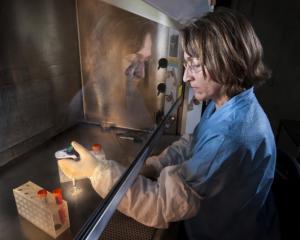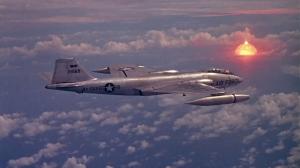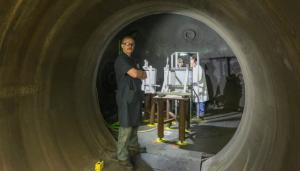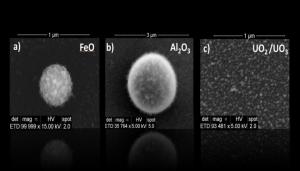LAB REPORT
Science and Technology Making Headlines
July 27, 2018


Lawrence Livermore scientists have found that mid-latitude regions of Northern Hemisphere continents have a large seasonal cycle of atmospheric temperature, with frigid winters and hot summers.
Human influence is in season
Pouring through four decades of satellite data, Lawrence Livermore climate scientists have concluded for the first time that humans are pushing seasonal temperatures out of balance. The team give “odds of roughly 5 in 1 million” of these changes occurring naturally, without human influence.
Like detectives, climate scientists are continually sifting through evidence looking for what they call “fingerprints.” Over the years, they’ve teased out the human signal from earthly noise in annual and decade-spanning temperature records, marine chemistry, rapid Arctic change and more.
What they discovered is an uneven pace of seasonal change in the atmosphere above the Northern and Southern Hemispheres’ temperate zones. While warming is famously global, summers in the troposphere are heating faster than winters, in a way physics would dictate if greenhouse gases were the culprit. The satellite data and computer models for seasonal temperature change used by the study agree with each other even more closely than they do when gauging average annual temperature.
Ben Santer, an LLNL atmospheric scientist, likens the temperature results to a wave washing up on a beach. For every year in the 38-year satellite record, the team captured the monthly temperature lows (troughs) and highs (crests). In the early years, the “waves” came in small. By the end of the data set under study, 2016, the waves crashed ashore with higher troughs -- and much higher crests.


Lawrence Livemore researcher Joanne Osburn places brain cells on the in vitro device to create the “brain-on-a-chip.”
It’s all in the chip
Research by Lawerence Livermore scientists may help validate organ-on-a-chip devices.
The scientists gave freely moving rodents two different drugs, atropine and ketamine, and recorded their neural activity using LLNL-fabricated multielectrode arrays implanted in their brains. They compared the neuronal spiking and bursting patterns with data gathered from LLNL’s brain-on-a-chip device, an in vitro (outside of the body/organism) platform consisting of purified rat neurons cultured on a multielectrode array, developed as an alternative to human testing for pharmaceutical drugs or chemical agents.
The researchers observed differences in baseline neural firing activity between the neural interfaces and chip-based systems, similar responses in spiking activity using atropine, and greater sensitivity to ketamine in cells cultured in chip-based devices than those seen in the rodents’ brains. Researchers cautioned the study isn’t a comprehensive validation, but rather an important initial step toward a more thorough comparison between in vivo (inside of the body/organism) and in vitro (outside the body/organism) responses.


Aerial shot of the explosion during a nuclear test called Hardtack I in the Marshall Islands.
The power of the bomb
Film from the decades-old nuclear tests are being restored, saved and studied by Lawrence Livermore nuclear physicists, in hopes of better understanding the power of the bombs.
“The United States stopped testing nuclear weapons in 1992,” said Greg Spriggs, a nuclear physicist at LLNL. “Now we do everything with computer code simulations. But a computer code simulation can be faulty. You have to verify that code is giving you the right answer.”
Spriggs said there are around 10,000 uncovered films. “It’s a pretty exciting project here," he said. "And we are looking at this almost like the tests were done yesterday, and this is kind of new data that's being supplied to the nuclear weapon complex.”
Spriggs said some of the conclusions from decades ago overestimated the strength of the nukes, some by as much as 30 percent.


Firing tank operator Drew Carlson (foreground) safeguards the mouth of the 10kg spherical tank at Lawrence Livermore’s High Explosives Applications Facility as Electronic Technician Raya Yy (background, left) and Ramrod Shawn Strickland wire a high explosive charge for an experiment. The experiment will provide data important to certifying that a refurbished nuclear warhead will work, replacing the need to conduct a full-scale explosive nuclear test. Photo by Julie Russell/LLNL
Jumping a hurdle
The nuclear arsenal of the United States has been aging since the height of the Cold War and the fall of the Soviet Union. Military officials have ramped up a "life extension program" to refurbish the weapons stockpile, but without the testing that requires actual detonations.
The W80, a relatively small warhead at just 250 pounds, became a major part of the American nuclear force in the 1980s, and was especially valued atop air-launched cruise missiles. But it has aged along with much of the other weaponry.
Now a team from Lawrence Livermore National Laboratory will refurbish the W80. Five milestones have been achieved, but 20 more remain to get the W80-4 into service and on alert by 2031.
Part of the plans involve finding new ways to reconstitute key components, which have not been manufactured for decades, according to officials.


Aerodynamically favored, perfectly spherical iron and aluminum oxide condensates were recovered using the recently developed experimental setup at Lawrence Livermore. Uranium oxide particles showed irregular features. LLNL scientists are creating these particles under controlled conditions to develop a first-principles understanding of how nuclear fallout forms.
The chemistry behind nuclear explosions
To understand fallout formation from a nuclear explosion, it's important to look at the gas phase of metal oxides within the device.
Lawrence Livermore scientists have developed a plasma-flow reactor to experimentally simulate the late cooling of post-detonation fireballs where temperature drops below 10,000 K. They investigate the formation of nanoparticles from gas phase atoms to unravel the chemical fractionation processes uranium and other chemical elements go through during fireball condensation. The research appears in a recent edition of the journal Scientific Reports.
The researchers hope to better understand the interconnection between chemical reactions and micro-physical processes (e.g. nucleation, condensation, growth, etc.) on time scales that are relevant to fallout formation.





